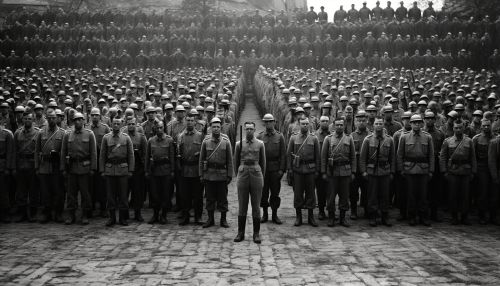World War II casualties
Overview
World War II, often abbreviated as WWII or WW2, was a global conflict that lasted from 1939 to 1945. It resulted in an estimated 70-85 million casualties, which was approximately 3-4% of the world's population at the time. This makes it the deadliest conflict in human history. The casualties of World War II were a direct result of military action, but also included the victims of strategic bombing, genocide, starvation, disease, and other war-related causes.
Military Casualties
Military casualties in World War II can be broken down into two categories: combat-related deaths and non-combat deaths. Combat-related deaths include those who were killed in action, died of wounds, or were missing in action and later declared dead. Non-combat deaths include those who died from accidents, disease, or other non-combat causes.
Combat-related deaths were the most common form of military casualties during World War II. The Axis suffered approximately 5.5 million combat-related deaths, while the Allied forces suffered approximately 16 million. The Soviet Union suffered the highest number of combat-related deaths, with an estimated 10.7 million military personnel killed.
Non-combat deaths were also a significant factor in the overall military casualties of World War II. The Axis powers suffered approximately 1 million non-combat deaths, while the Allies suffered approximately 4 million. The United States had the highest number of non-combat deaths, with an estimated 1.1 million military personnel dying from non-combat causes.


Civilian Casualties
Civilian casualties in World War II were a result of direct military action, strategic bombing, genocide, starvation, disease, and other war-related causes. The total number of civilian deaths during World War II is estimated to be between 40-52 million.
Direct military action resulted in the deaths of millions of civilians during World War II. This includes civilians who were killed during ground combat, air raids, naval bombardment, and other forms of direct military action. The Battle of Stalingrad is one example of a battle that resulted in a high number of civilian casualties, with an estimated 40,000 civilians killed during the battle.
Strategic bombing also resulted in a significant number of civilian casualties during World War II. The bombing campaigns carried out by the Allies against Germany and Japan resulted in the deaths of millions of civilians. The bombing of Dresden and the atomic bombings of Hiroshima and Nagasaki are two examples of strategic bombing campaigns that resulted in a high number of civilian casualties.
Genocide, particularly the Holocaust, was another major cause of civilian casualties during World War II. The Holocaust resulted in the deaths of approximately 6 million Jews, along with millions of other people who were targeted by the Nazi regime.
Starvation and disease also resulted in a significant number of civilian casualties during World War II. The siege of Leningrad, for example, resulted in the deaths of an estimated 1 million civilians due to starvation and disease.
Post-War Casualties
The end of World War II did not immediately result in an end to the casualties. Millions of people continued to die in the years following the war as a result of the long-term effects of the conflict.
One of the major causes of post-war casualties was the displacement of people. Millions of people were displaced as a result of the war, leading to a refugee crisis that resulted in a significant number of deaths. The expulsion of Germans from Eastern Europe, for example, resulted in the deaths of an estimated 500,000 to 2 million people.
The long-term effects of strategic bombing also resulted in a significant number of post-war casualties. The atomic bombings of Hiroshima and Nagasaki, for example, resulted in the deaths of an estimated 90,000-146,000 people in Hiroshima and 39,000-80,000 people in Nagasaki in the years following the bombings due to the effects of radiation.
In addition, the economic devastation caused by the war resulted in a significant number of deaths due to starvation and disease. This was particularly true in countries that were heavily affected by the war, such as the Soviet Union and China.
